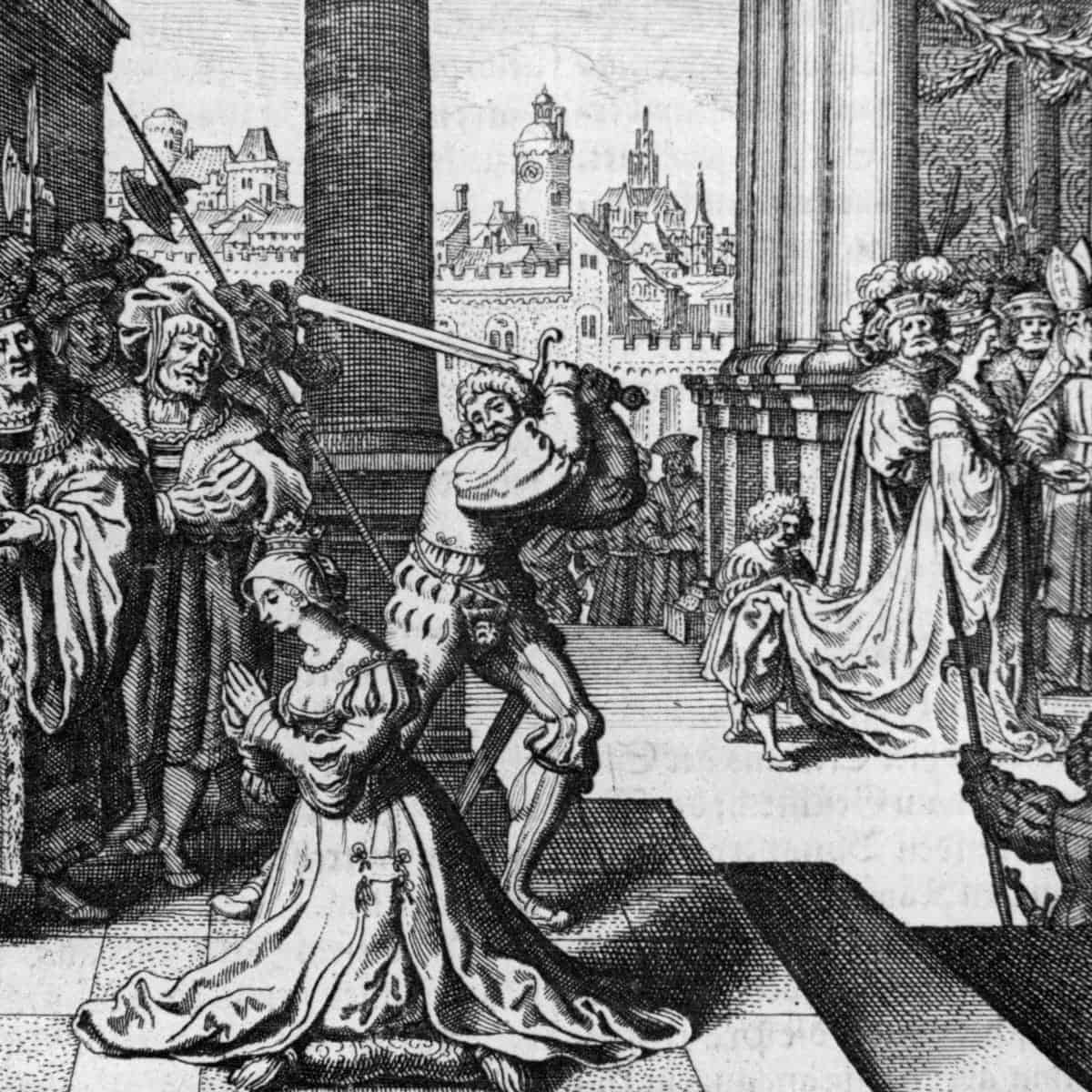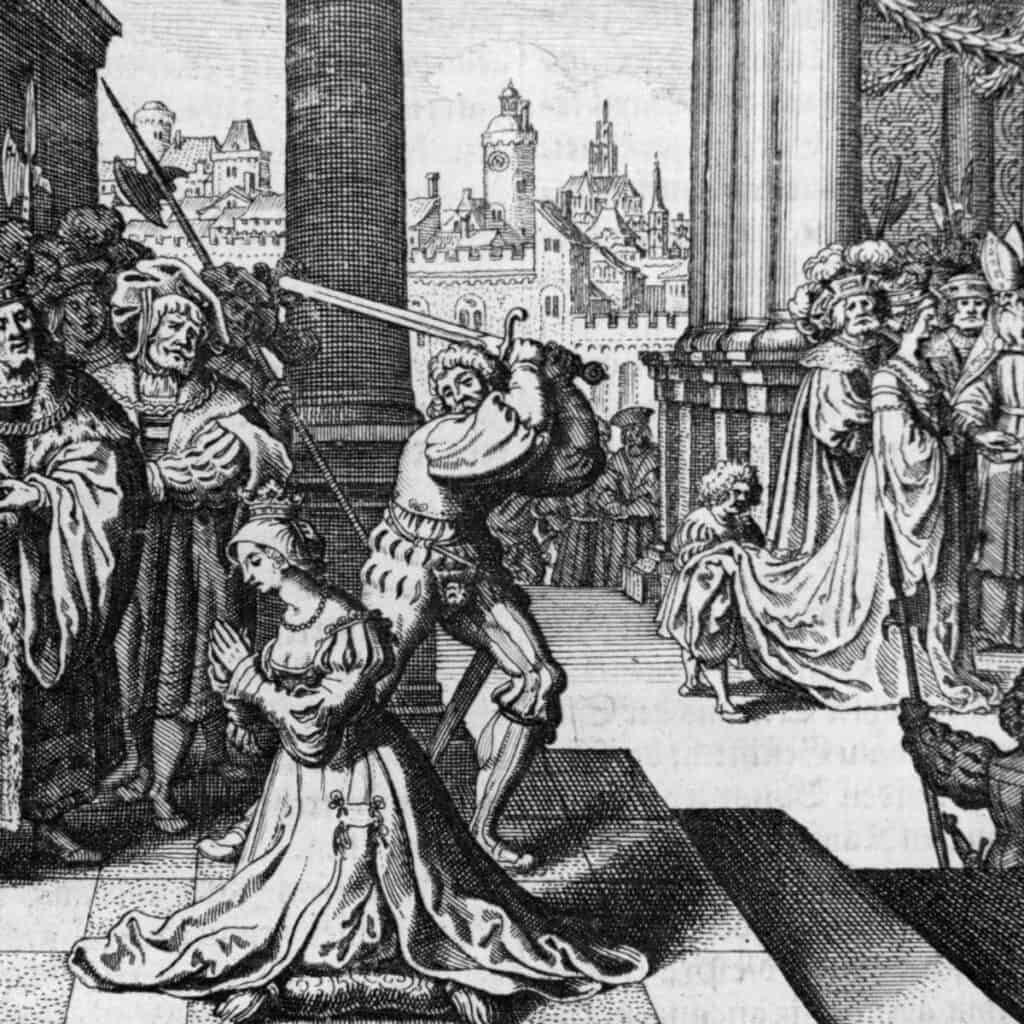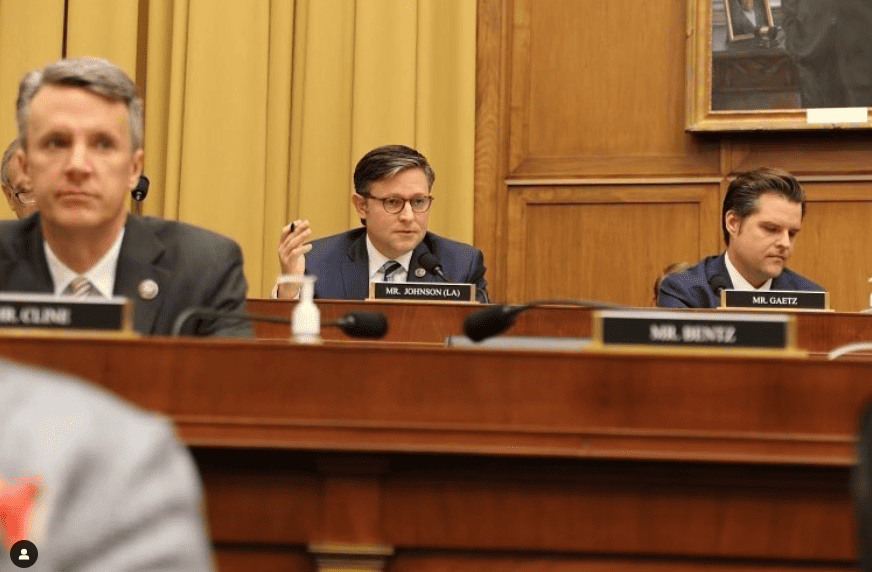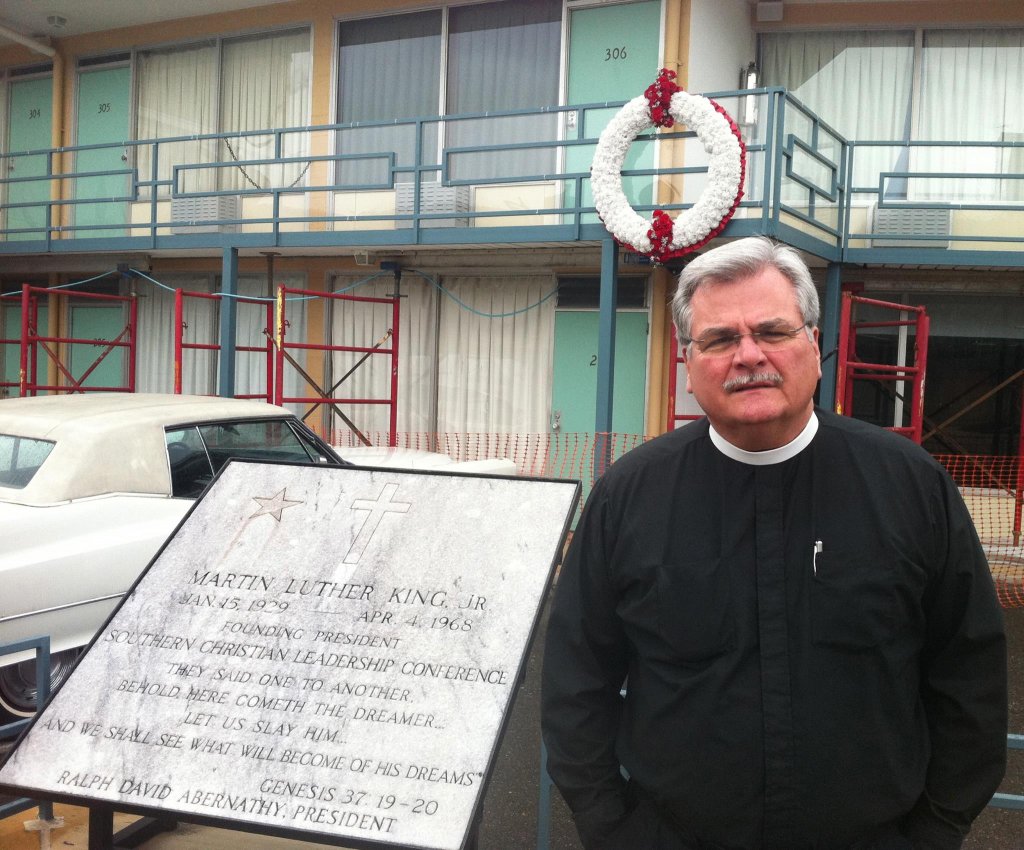We meet at “The Gift” a few minutes after high noon on a sunny spring afternoon. Though our feet are planted in Iowa soil, our hearts and minds had been transported back in time five hundred years. “The Gift” stands near the main classroom building of Dordt University in Sioux Center, IA. It is an androgynous nude figure mounted on a pedestal with arms outstretched towards the campus, looking like the result of an unfortunate tryst between C. S. Lewis’ Mr. Tumnus and Stephen Moffat’s Weeping Angels. Today, the silent sentinel of Dordt University will witness what is labeled by some of my class as a tragic miscarriage of justice and by others as the vindication of God’s divine rule over His Majesty’s realm.
Jessica Lillo, who has become Thomas Cromwell in recent weeks, and Rachel Hawkins, the Burgess of Colchester, have run out of time. Though they managed to secure the execution of Anne Boleyn together, their parliamentary enemies were able to turn King Henry against them in the end. They now face the king’s wrath at the blade of an axe, which in this case looks suspiciously like a nerf sword. Justin Vos as Archbishop of Canterbury Thomas Cranmer comes forward to read the charges against the condemned and to pray for their eternal souls as they kneel before the assembled group. Our Thomas Cranmer tends to be a little verbose. His speech grows more flamboyant and lengthy as he relishes his role in this macabre final act. The good Burgess of Colchester begins to feel the pressure of her impending doom, breaking character to yell, “Justin, just shut up and do it!” The prayers are finished, the axe descends, the kingdom is secure, and the king begins to consider which lucky maiden or matron he can marry next. We retire to “Westminster Palace,” formerly known as Classroom Building #120, to feast on the king’s bounty and reflect on the journey we have been taking through the English Reformation.
Teaching a theologically loaded topic like the English Reformation or Reformations, if we use Christopher Haigh and Carter Lindberg’s categorization, in a confessional context calls for a calculated mixture of informed argumentation, directed imagination, and a few executions along the way.[1] In some ways, potential student bias in a confessional context, in this case a Reformed Christian context, challenges objective engagement no more than the presuppositions other students bring to their studies in non-confessional contexts. The difference lies in the kinds of presuppositions they bring, often nurtured by the particular denominational tradition or theological orientation with which they identify and the higher stakes they may perceive in challenging their inherited traditions. While challenges to an accepted worldview can bring discomfort for any student, confessional students can view raising questions about theology or the fundamental foundations of their belief system as entertaining heresy at best and possibly even risking harm to their eternal soul. Reassuring them that it is not only okay, but beneficial, to consider other perspectives and opening windows for them to make those explorations in the most expansive way possible makes the confessional classroom both challenging and exciting.
The English Reformation poses a particular conundrum for those students who grew up with a romanticized version of “the Reformation” because it is easily the most earthy of them all.
Not that the other reform movements are free of Machiavellian political machinations, ironic contradictions, and strange bedfellows, but the English context simply bares those elements more. Cambridge dissidents at the White Horse Inn share time with the revolving conquests entering and leaving Henry VIII’s bedchamber. Religious change in England appears engineered as much by legislative fiat as spiritual conviction-possibly more so. Protestant students have to grapple with the reality that Anne Boleyn’s ability to influence her husband and to advance the ambitions of Protestant courtiers rested on her infidelities with a married man, contemptuous displacement of his faithful wife, and mistreatment of her powerless stepdaughter. Protestant students raised to question the very salvation of Roman Catholics are confronted with individuals such as Catherine of Aragon and Thomas More, whose beliefs were as sincere as those of their Protestant counterparts. Their behavior was sometimes more ethical, especially when comparing Catherine with Anne. These considerations raise all kinds of fascinating discussions regarding the relationship between religious belief and historical memory in light of how some Protestant interpreters, such as John Foxe, in the next generation adopted an “end justifies the means” mentality to vindicate Anne’s legacy. Foxe wrote of Anne that she was a “godly and Christian woman.”[2] Our class examines through primary source readings polarized opinions about Anne from Protestant and Catholic writers of the next generation. Through these sources, students derive a sense of how historical memory is shaped by the political and social needs of communities. These conversations and the paper students write in response to the primary sources helps break down some of their prejudicial assumptions about the reliability of testimony regarding the English Reformation. They begin to weigh sources critically.
One key tool I use for getting students to understand the complexity of the English Reformation is evocative role-playing. Evocation, a term fiction writers often use to describe their attempts to make imaginary worlds real for their readers, stands at the heart of historical simulations I use for this and several other courses as well[3]. Barnard College professor of history Mark C. Carnes refers to learning through historical simulations as “subversive play” in his book Minds on Fire. Carnes played a leading role in developing simulations for the college classroom and created the Reacting to the Past consortium, a group that designs simulations and promotes their use across the disciplines. Carnes argued that “subversive play worlds” are created by students across campus all the time. These play worlds, like medieval carnival traditions, allow for the assumption of new identities in imaginary worlds where the rules are redefined. Carnes suggested that college instructors could harness for academic purposes the same impulses that draw students to Greek life or to create an “Assassins” or “Humans versus Zombies” game on campus.[4]
I utilize a number of simulations in my course “Witch Hunts, Wars, and Reformations.” The two simulations I created myself focus on the Diet of Worms and our reading of The Return of Martin Guerre by Natalie Zemon Davis.[5] Both of these exercises adopt a trial or debate format. Students take on roles and attempt to argue their cases. The victor is determined by a panel of indeterminate judges who we appoint at the beginning. One of my favorite stories from the Diet of Worms debate involves a student who was known for his steadfast dedication to a conservative Reformed theology. He was considered the campus amateur theologian, highly respected by his peers and always ready to defend the legacy of John Calvin. I gave him a Roman Catholic role for the Diet of Worms simulation. His competitive nature took over, and he did well. In fact, he did too well for his own taste. The Luther faction stood in tatters as he decimated them. He was so devastated by their poor performance that he started to throw out hints to the opposing Lutherans even as he brought his own arguments together for the rhetorical kill. The situation grew more and more hilarious as the Luther delegates failed to pick up any of his hints and, as a result, his hints grew more obvious. The dissonance was strong with this one. He did not mind winning, but he really hated to win with such a poor showing on the part of those who were advocating his own position. But he did do it and did it well. The evocative nature of the exercise and the sense of temporary alternative reality allowed him to argue contrary to beliefs he would never challenge in real life. He accepted the premise that the exercise was a historical laboratory where he was free to live out an alternative persona in pursuit of greater understanding and empathy.
We do something similar with The Return of Martin Guerre. The students are assigned roles based on historical characters in the book. They are tasked with learning everything they can about these characters and their perspectives. We then reenact the trial over two class sessions and then spend the third one discussing questions raised by our reading and our reenactment. Did Bertrande know that the stranger was not her husband and was she complicit in his deception? Would the real Martin have returned had he not heard rumors of the imposter? After our discussion, we schedule a movie night, usually at my house, to view the film project that spurred Davis to write the book.
The longer simulation for the class and the most complex deals with the English Reformation. Henry VIII and the Reformation Parliament was developed by Smith College professor of government John Patrick Colby as part of the Reacting to the Past series.[6] Colby created several possible schedules that instructors can adopt. I use the full three-week simulation, though there are also more compressed options. Instructors should consider the amount of time involved and understand that they are giving up time that can be devoted to other topics. On the other hand, the payoff in terms of student learning and engagement justifies sacrificing time and some topics. In addition, the simulation does cover more than just the main topic. In the case of Henry VIII, students prepare by reading Martin Luther, Niccolo Machiavelli, and Desiderius Erasmus as well as primary source documents directly related to acts of Parliament during the English Reformation.
After discussing their readings in class and setting the historical context for about three or four class sessions, I distribute their role sheets. The whole simulation stands on the detailed nature of these role sheets and how well students follow them. (See sample role sheets) The role sheets provide a detailed description of who their character is, what positions they endorse and oppose, and a guide to further reading. In these role sheets each student receives objectives that they must work to achieve. Some of these goals are individual goals and some are faction goals they share with other characters.
Role sheets and the instructor’s guide are available for download through the Reacting Consortium Library web site.[7] Instructors can request permission to access the site and all the materials on it using a form provided on the site. The vetting process insures the security of the instructor’s materials and the integrity of the simulations by preventing students from seeing information that could give them an unfair advantage over classmates and therefore ruin the simulation. Those with access to the site promise to keep instructor materials confidential, with the exception of the role sheets, and must request permission to print materials for unpublished games. Students are instructed to keep information on their role sheets to themselves unless they are directed to do otherwise on the role sheet. Most of them keep this rule very well because they know that careless sharing of information might doom their chances to win the simulation exercise.
Most Reacting to the Past simulations require the professor to play a primarily background role as the simulation gets under way. The Henry VIII and the Reformation Parliament simulation differs from most by casting the professor in the role of Henry VIII himself. Henry opens each session of Parliament with updates and instructions to the members. He will often update them about events that have been transpiring outside the sessions as we move from 1529 to 1536, the final year of the simulation. Which of us who love this era have not secretly wanted to enjoy being Henry VIII? The professor gets to bluster, bully, and cajole the students as M. P.’s and clergy to secure his divorce and separation from the church as painlessly as they can. King Henry express his royal displeasure when things do not go well for his case. The king also dispenses patronage in the form of poker chips, which can strengthen a member’s voting power. Anne and the Boleyn family can also dispense patronage to support their allies. The Pope and ambassadors such as Eustace Chapuys, representative of Emperor Charles V, also have limited power to use patronage in support of parliamentarians who favor their causes.
The course of the debates amply demonstrates our earlier comments on the halting and erratic nature of the English Reformation legislation. Students learn about each phase of the Reformation from the earliest proposals to limit appeals to Rome by the clergy to the dissolution of the monastic houses in 1536 and 37. Clergy members of the group will enter convocation to debate legislation, try students accused of heresy, and issue requests to parliament. They not only read the parliamentary acts; students also have to know them backwards and forwards because they are required to argue for or against each act. The same is true of the primary source readings they have done prior to the simulation. Students are graded on both their oral argumentation and ten to twelve pages of written work that they submit over the course of the simulation. For both the oral and written components, they are required to draw heavily on the primary source materials to make their arguments. It is not enough to say that the king has a right to separate from the Roman Catholic Church. Students support their assertions by arguing, for instance, that Martin Luther provides a strong rationale for the primacy of local rulers over church hierarchy in his Address to the Christian Nobility of the German People.[8] Alex Rexford, playing Thomas Boleyn, reached back to the historic showdown between Henry II and Thomas Beckett to demonstrate the nefarious attempts by the church to control England throughout her history. Her opponents cited Henry’s submission at Canterbury after Beckett’s death as a demonstration that he had come to recognize papal authority, an argument that Alex immediately attacked in light of Henry’s later actions. Students need to cite sources and quote them extensively to do well. Their grade reflects how well they accomplish their “victory objectives” to some degree, but the greater weight is placed on how well they embody their characters and support their arguments with data drawn from the primary source materials.
Our simulation resulted in Thomas Cromwell’s execution due to some historical compression that takes place at the end to make things more interesting. Even though Anne died four years before Cromwell in reality, the simulation provides the opportunity for the Pro-Anne faction to indict Cromwell as well if they can get the votes in Parliament. When they are successful, the dueling attainders and trials provide an explosive conclusion. Sometimes one side or the other wins. In other instances, a sort of mutually assured destruction plays out in which Cromwell and Anne, former allies, now doom each other. There is no person who plays the role of Anne in the simulation, a slight weakness. Anne is represented and discussed, but does not appear unless the Knight of Berkshire, Henry Norris who was later accused of being one of her lovers, chooses to host a bonus banquet outside of class where he can invite someone to portray Anne. So, since there was no Anne to behead, our Cromwell was destined to go to the block alone. At the last minute, the remaining M. P.’s decided to pass a bill of attainder against Colchester too because he/she had been instrumental in helping Cromwell condemn Anne. And so, they paved the road that led us to the foot of “The Gift.”
One of the advantages and challenges of Reacting to the Past simulations is the possibility of alternative historical outcomes. The potential for students to alter history was imbedded in the structure of the simulation for good reason. There is no challenge if students are only parroting the history. It is not as engaging because there are no stakes and the students are only going through the motions of an elaborate skit. The problem is, of course, that students may come to learn false information about historical outcomes. Professors want to avoid reinforcing in the classroom incorrect historical information that already gets passed too often through popular cultural mediums such as movies, television, and historical novels.
Simulation outcomes in my classes reflect the historical record in some cases and at times go against the grain of history. Both conclusions provide teachable moments in different ways. At least one, and sometimes two, sessions are devoted to “debriefing” at the end of each simulation. These sessions allow the instructor to cover the actual historical outcomes as well as to discuss why our particular version turned out the way it did. The final debrief reinforces the true historical facts while using any deviations from actual history to give us insight into the historical personalities and our own inherent biases. These moments open the door to a review of things we have already said about the fickle nature of historical memory and historiography.
Evocation through subversive play ushers students into an imaginary recreation of the past. It subverts their natural defenses and opens their minds to entertaining, and even defending, views that are not their own. At the end of the exercise, the hope is that they will understand better how equally rational people can come to opposite conclusions when encountering the same facts. Though they may never alter their confessional stance, students are better equipped to empathize with those whose commitments lie outside their confessional views and work productively with them to shape the larger societies that we all share.
This essay is from our Anastasis Series where we resurrect articles from the past that are still relevant today. This piece was first published on May 13, 2022, and has been lightly edited and updated.
[1] Christopher Haigh, English Reformations: Religion, Politics, and Society Under the Tudors, (Gloucestershire, UK: Clarendon Press, 1993).
[2]John Foxe, The acts and monuments of John Foxe; with a life of the martyrologist, and vindication of the work, Vol. 5, Ed. George Townsend, (New York, NY: AMS Press, 1965), 232-234.
[3] Mark C. Carnes, Minds On Fire: How Role Immersion Games Transform College, (Cambridge, MA: Harvard University Press, 2014), 37-86.
[4] Carnes, 58-61.
[5] Natalie Zemon Davis, The Return of Martin Guerre, (Cambridge, MA: Harvard University Press, 1983).
[6] John Patrick Colby, Henry VIII and the Reformation Parliament, (New York, NY: W. W. Norton and Company, 2013).
[7] Reacting to the Past Consortium, “Reacting Consortium Library,” https://reactingconsortiumlibrary.org/ , (Accessed June 13, 2017).
[8] Martin Luther, “Address to the Christian Nobility of the German People,” Three Treatises, Trans. Charles M. Jacobs, (Philadelphia, PA: Fortress Press, 1990).








